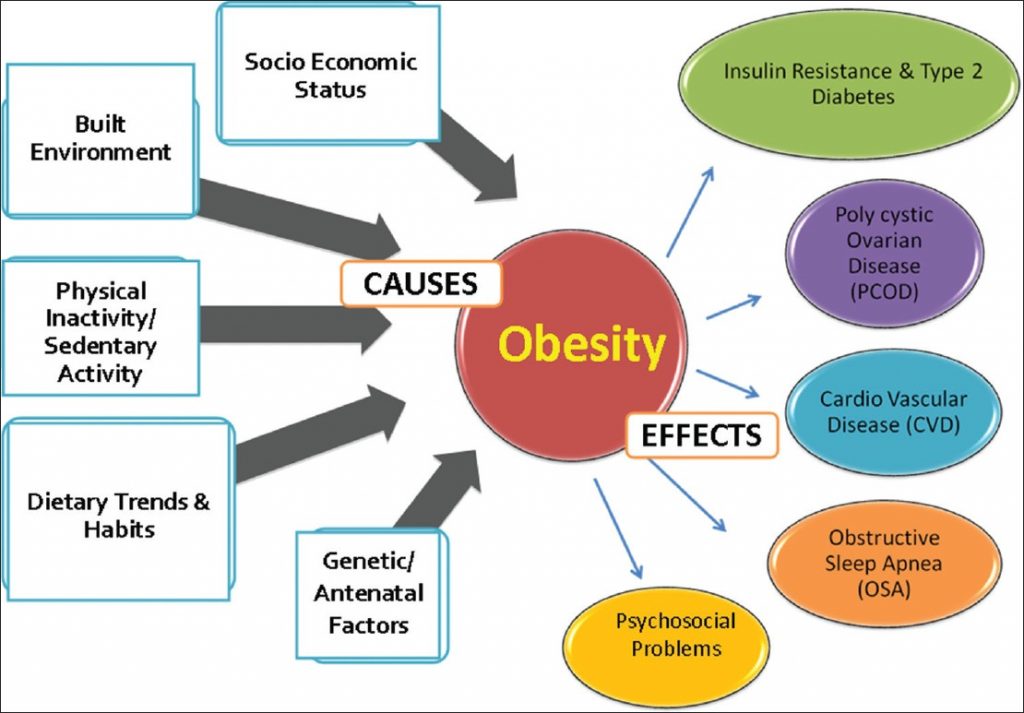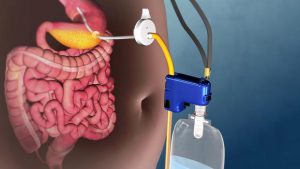How to lose body fat? Since obesity is a pandemic and losing weight is hard, everybody is interested in reading articles like “how to lose weight in three days”, “how to lose weight without dieting”.
However, losing weight is not that easy. If you understand obesity, losing weight will become easy. You can also read the articles “How to lose weight without medicines“, Unexplained weight gain and “bariatric surgery – The only effective treatment of extreme obesity”.
Obesity is a state of the excess adipose tissue mass.
Obesity is a disease of caloric imbalance that results from an excess intake of calories above their consumption by the body.
The WHO definition is:
BMI greater than or equal to 25 is overweight
BMI greater than or equal to 30 is obesity.
BMI/ Quetelet index
Classification of weight status is NOT by mere weight. Muscularity & height affect weight. So, BMI or Quetelet index used to classify. Body Mass Index (BMI) Most widely used
BMI= Weight(kg) / Height (m2)
Classification
| <18.5 | Underweight |
| 18.5 – 24.9 | Normal |
| 25 – 29.9 | Overweight |
| 30 – 34.9 | Obese class I |
| 35 – 39.9 | Obese class II |
| 40 – 49.9 | Obese class III |
| >50 | Super Obesity |
The above scale is used for the US and western countries.
Suggested BMI and WC measurements to determine the risk of co-morbidities in Asians:
classification | BMI | Risk of comorbidities | |
|
| Waist circumference | |
|
| <90 (men) | >90 (men) |
|
| <80 (women) | >80 (women) |
underweight | <18.5 | Low (but increased risk of other clinical problems | Average |
Normal range | 18.5 – 22.9 |
|
|
overweight | >23 | average | increased |
At risk | 23 – 24.9 | increased | moderate |
Obese 1 | 25-29.9 | moderate | severe |
Obese 2 | >30 | severe | Very severe |
Prevalence of Obesity in Pakistan
- Prevalence of obesity (BMl>25) in 25-44-year-olds
- in rural areas was 9% for men and 14% for women
- in urban areas, 22% and 37% for men and women,
- For 45-64 year-olds, prevalence was
- 11 % for men and19% for women in rural areas and
- 23% for men and 40% for women in urban areas.
Another recent Pakistani study done in 2016/2017 shows:
- For overweight and obesity, we have chosen the WHO cut-offs, and the prevalence is 62.1% and 47.5%, respectively,
- while from Asian cut-offs, these figures are 76.2% and 62.1%.
That means more than half the people in our country are obese.
What Causes Obesity?
- Lack of energy balance
- Genes and family history (LEPTINS, GHRELINS and ADIPONECTIN are hormones in our body that regulates appetite and the will to workout. Any mutations in the genes that produce these hormones will cause obesity)
- Endocrine problems like Hypothyroidism, Cushing’s syndrome and Polycystic Ovarian Disease
- Drugs like: Corticosteroids, Antidepressants and seizure Medicines
- Emotional Factors
- Alcoholism
- Smoking cessation
- Pregnancy
- Lack of sleep
- An inactive lifestyle
- Work schedules
- Lack of access to healthy foods
- Food advertising
- Lack of neighbourhood sidewalks and safe places for recreation
How Much weight is gained with extra calories:
1 pound (0.45kg) of weight is gained when about 3500 calories are consumed.
If a person takes 100 calories extra per day, in one year that accounts to 36500 extra calories. This will cause a 10.4 lbs or 4.72 Kg of weight gain.
Now the question is: How much are a “100 calories”?
Answer: Not very much!
- 1 glass skim milk, or
- 1 banana, or
- 1 slice cheese, or
- 1 tablespoon butter.
MEDICAL COMPLICATIONS OF OBESITY
- Diabetes Mellitus: 80% of type 2 diabetics are obese. That’s because Diabetes is very common in obese people
- Cardiovascular System: Coronary Artery Disease, Congestive Heart Failure, Hypertension
- Male/Females reproductive problems
- Pickwickian Syndrome: Apnoeic pauses during sleep, Hypersomnolence at both day&night, Polycythemia, Eventually right-sided heart failure
- Gastro-Intestinal Tract: Gallstones, High cholesterol, Pancreatitis, Abdominal hernias, Non-Alcoholic-Fatty-Liver-Diseases
- Stroke
- Sleep disturbances
- Osteoarthritis
- GOUT
- Skin: Acanthosis Nigricans, Friability of skin that enhances fungal and yeast infections of the skin
- Cancers of the Esophagus, Colon, Rectum, Pancreas, Liver, Prostate, Gallbladder, Bile duct, Endometrium, cervix, ovaries
Medical conditions that cause Obesity:
- Cushing Syndrome
- Hypothyroidism
- Insulinoma
- Craniopharyngioma
Management of OBESITY – How to lose body fat?
The following steps of weight loss should be followed in order to lose weight steadily:
- Diet Therapy
- Physical Activity Therapy
- Behavioural Therapy
- Pharmacotherapy
- Surgery
Treatment Approach
Initial goal to lose body fat is to set a target of losing 10% body fat. 10% for a 100 Kg person means losing 10 kgs of weight. This will significantly decrease the risks associated with obesity as discussed above.
At what rate should you start losing weight?
- The optimal target is to lose around 1 to 2 pounds per week. This means reducing the caloric intake by 500 to 1000 calories per day. This Slow weight loss is more stable than the rapid weight loss.
- Rapid weight loss is almost always followed by weight gain and makes a person prone to electrolyte imbalances and the risks of developing gallstones.
One should aim for 4 – 6 months of weight loss effort. Most people will lose 20 to 25 pounds over the initial six months period. After 6 months, weight loss is more difficult. Set goals for weight maintenance for the next 6 months, then reassess.
Dietary Therapy – how to lose body fat?
- Weight reduction with dietary treatment is recommended for virtually all patients with a BMI 25-30 who have comorbidities and for all patients over BMI 30.
- Strategies of dietary therapy include teaching about the calorie content of different foods, food composition (fats, carbohydrates, and proteins), reading nutrition labels, types of foods to buy, and how to prepare foods.
Low-Calorie Step I Diet
- 1000 to 1200 kcal/day for women
- 1200 to 1600 kcal/day for men
Adjust for current weight & activity
- If you feel too hungry, increase kcal by 100 – 200/day
- If you are not losing weight, decrease kcal by 100 – 200/day
How Much are 1200 Calories?
- Could you stick to 1200 per day?
1 Big Mac (580)
1 SMALL Fries (210)
1 SMALL shake (430)
| Nutrients | Recommended intake |
| Calories | 500 – 1000 kcal/day reduction from usual |
| Total fat | <30% of total calories |
| Cholesterol | <300mg/day |
| Proteins | <15% of total calories |
| Carbohydrates | >55% of total calories |
| Sodium Chloride | <2.4g of Sodium or <6g of Sodium chloride |
| Calcium | 1000 – 1500mg / day |
| Fibre | 20 – 30g / day |
Once weight loss is achieved then maintenance of weight is started with a daily average calories intake as below:
Males:
Age 20 – 49 2900 calories / day
Age 50 plus 2500 calories / day
Females:
Age 20 – 49 2300 calories / day
Age 50 plus 1900 calories / day
Physical Activity
- Physical activity should be an integral part of weight loss
- Physical activity alone is less successful than a combined diet & exercise program
- Increased activity alone does not decrease weight
- Sustained activity does prevent weight regain
Start slowly
- Many obese people live sedentary lives
- Avoid injury
- Early changes can be activities of daily living
- Increase intensity & duration gradually
Long-term goal
- 30 to 45 minutes or more of physical activity
- 5 or more days per week
- Burn 1000+ calories per week
Pharmacotherapy for Weight Loss
- Pharmacotherapy should be an Adjunct to diet & physical activity
- It should be used in individuals with a BMI ≥ 30 Or, BMI ≥ 27 with other risk factors
- It Should not be used for cosmetic weight loss, Only for risk reduction
- Use only when the 6-month trial of diet & physical activity fails to achieve weight loss
- These drugs are only modestly effective and lead to 2 to 10-kilogram loss
- Most occurs in the first 6 months
- If the patient does not lose 2 kilograms in the first 4 weeks, success is unlikely
- If the first 6 months is successful, continue medication as long as…
- It is effective in maintaining weight, and
- Adverse effects are not serious
Medicines used to lose body fat
- Orlistat à Inhibit pancreatic lipases à Decreased absorption of fats
- Lorcaserin à 5HT2c agonist à early satiety
- Rimonabant à Cannabinoid CB1 receptor blocker à Decrease Hunger
- Phentermine à Appetite suppressant
- Topiramate à wt loss is a side effect (Mech. Unknown)
- Naltrexone an Opioid receptor partial agonist/antagonist
- Bupropion à NDRI à antidepressant/smoking cessation
- Sibutramine à monoamine reuptake inhibitor à appetite suppressant
Here is a list of some other weight loss drugs which has serious side effects and its use was stopped:

Bariatric Surgery/ weight loss surgery – cardiometabolic surgery
Indications for bariatric surgery
- 100 pounds overweight or more
- Or, BMI > 40
- Or, BMI > 35 and 2 significant comorbidities
- Age 18 to 60
- Documented failure at nonsurgical efforts
- Psychological stability
Complications of surgery:
- Mortality
- <1% mortality in healthy young adults BMI < 50
- 2-4% mortality in patients with disease and BMI > 60
- Operative complications of < 10%
- Late complications are uncommon and includes:
- Incisional hernias
- Gallstones
- Vitamin B & iron deficiency
- Weight loss failure
- Neurologic symptoms in unusual cases
Weight Loss Surgery Outcomes
From a meta-analysis published in JAMA
- Durable weight loss
- One study followed pts for 14 years
- Average excess weight loss = 61.2%
- 77% with diabetes no longer require meds
- 47,000 surgeries done in 2001; 98,000 in 2003; 228000 in 2017
Types of Obesity Surgery:
- Restrictive Surgery – uses bands or staples to create food intake restriction:
- Vertical Banded Gastroplasty (VBG)
- Gastric Banding
- Laparoscopic Gastric Banding (Lap-Band),
- Combined Restrictive and Malabsorptive Surgery: is a combination of restrictive surgery (stomach pouch) with bypass (malabsorptive surgery), in which the stomach is connected to the jejunum or ileum of the small intestine, bypassing the duodenum.
- Roux-en-Y Gastric Bypass (RGB)
- Biliopancreatic Diversion (BPD) –
Aspiration Therapy:
This is a new surgical technique used for weight loss in which a tube in the stomach is connected to the skin outside the body, through which food can be aspirated out of the stomach.
This study below shows that there was a significant reduction in weight after Aspiration Therapy in patients whose BMI was >35 kg/m2
This study below concluded that obese patients who underwent surgeries had a significant remission of Hypertension and diabetes. Also, there is a significant decrease in new-onset diabetes and hypertension in patients who underwent surgery.
Let’s not forget that despite all these good results, there is some serious complication to surgeries also. There are studies which suggest that apart from the clinical complication of surgeries there is an increased risk of depression and drug abuse in patients who underwent weight loss surgeries.
Also even in case of surgical treatment for obesity, failure of treatment is pretty common. So it is always best to consult your doctor for management of your obesity.








